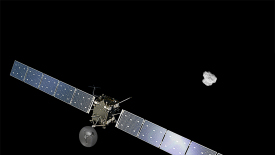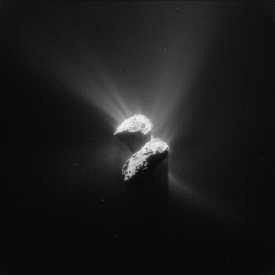Rosetta mission extended
23 June 2015
The adventure continues: ESA today confirmed that its Rosetta mission will be extended until the end of September 2016, at which point the spacecraft will most likely be landed on the surface of Comet 67P/Churyumov-Gerasimenko.
 |
| Rosetta arrives at the comet. Credit: Spacecraft: ESA/ATG medialab; Comet image: ESA/Rosetta/NAVCAM |
Rosetta was launched in 2004 and arrived at the comet in August 2014, where it has been studying the nucleus and its environment as the comet moves along its 6.5-year orbit closer to the Sun. After a detailed survey, Rosetta deployed the lander, Philae, to the surface on 12 November. Philae fell into hibernation after 57 hours of initial scientific operations, but recently awoke and made contact with Rosetta again.
Rosetta's nominal mission was originally funded until the end of December 2015, but at a meeting today, ESA's Science Programme Committee has given formal approval to continue the mission for an additional nine months. At that point, as the comet moves far away from the Sun again, there will no longer be enough solar power to run Rosetta's set of scientific instrumentation efficiently.
"This is fantastic news for science," says Matt Taylor, ESA's Rosetta Project Scientist. "We'll be able to monitor the decline in the comet's activity as we move away from the Sun again, and we'll have the opportunity to fly closer to the comet to continue collecting more unique data. By comparing detailed 'before and after' data, we'll have a much better understanding of how comets evolve during their lifetimes."
Comet 67P/Churyumov-Gerasimenko will make its closest approach to the Sun on 13 August and Rosetta has been watching its activity increase over the last year. Continuing its study of the comet in the year following perihelion will give scientists a fuller picture of how a comet's activity waxes and wanes along its orbit.
The extra observations collected by Rosetta will also provide additional context for complementary Earth-based observations of the comet. At present, the comet is close to the line-of-sight to the Sun, making ground-based observations difficult.
 |
| Comet 67P/C-G on 5 June 2015 - NavCam. Credit: ESA/Rosetta/NAVCAM, CC BY-SA IGO 3.0 |
As the activity diminishes post-perihelion, it should be possible to move the orbiter much closer to the comet's nucleus again, to make a detailed survey of changes in the comet's properties during its brief 'summer'.
In addition, there may be an opportunity to make a definitive visual identification of Philae. Although candidates have been seen in images acquired from a distance of 20 km, images taken from 10 km or less after perihelion could provide the most compelling confirmation.
During the extended mission, the team will use the experience gained in operating Rosetta in the challenging cometary environment to carry out some new and potentially slightly riskier investigations, including flights across the night-side of the comet to observe the plasma, dust, and gas interactions in this region, and to collect dust samples ejected close to the nucleus.
As the comet recedes from the Sun, the solar-powered spacecraft will no longer receive enough sunlight to operate efficiently and safely, equivalent to the situation in June 2011 when the spacecraft was put into hibernation for 31 months for the most distant leg of its journey out towards the orbit of Jupiter.
In addition, Rosetta and the comet will again be close to the Sun as seen from the Earth in October 2016, making operations difficult by then.
However, with Rosetta's propellant largely depleted by that time, it makes little sense to place the spacecraft in hibernation again.
"This time, as we're riding along next to the comet, the most logical way to end the mission is to set Rosetta down on the surface," says Patrick Martin, Rosetta Mission Manager.
"But there is still a lot to do to confirm that this end-of-mission scenario is possible. We'll first have to see what the status of the spacecraft is after perihelion and how well it is performing close to the comet, and later we will have to try and determine where on the surface we can have a touchdown."
If this proposed scenario were played out, then the spacecraft would be commanded to spiral down to the comet over a period of about three months.
It is expected that science operations would continue throughout this period and be feasible up to very close to the end of mission, allowing Rosetta's instruments to gather unique data at unprecedentedly close distances.
Once the orbiter lands on the surface, however, it is highly unlikely to be able to continue operations and relay data back to Earth, bringing to an end one of the most successful space exploration missions of all time.
About Rosetta
Rosetta is an ESA mission with contributions from its Member States and NASA. Rosetta's Philae lander was provided by a consortium led by DLR, MPS, CNES and ASI. Rosetta is the first mission in history to rendezvous with a comet. It is escorting the comet as they orbit the Sun together. Philae landed on the comet on 12 November 2014. Comets are time capsules containing primitive material left over from the epoch when the Sun and its planets formed. By studying the gas, dust and structure of the nucleus and organic materials associated with the comet, via both remote and in situ observations, the Rosetta mission should become the key to unlocking the history and evolution of our Solar System.
For further information, please contact:
Markus Bauer
ESA Science and Robotic Exploration Communication Officer
Tel: +31 71 565 6799
Mob: +31 61 594 3 954
Email: markus.bauer![]() esa.int
esa.int
Patrick Martin
ESA Rosetta Mission Manager
Email: Patrick.martin![]() esa.int
esa.int
Matt Taylor
ESA Rosetta project scientist
Email: matthew.taylor![]() esa.int
esa.int


